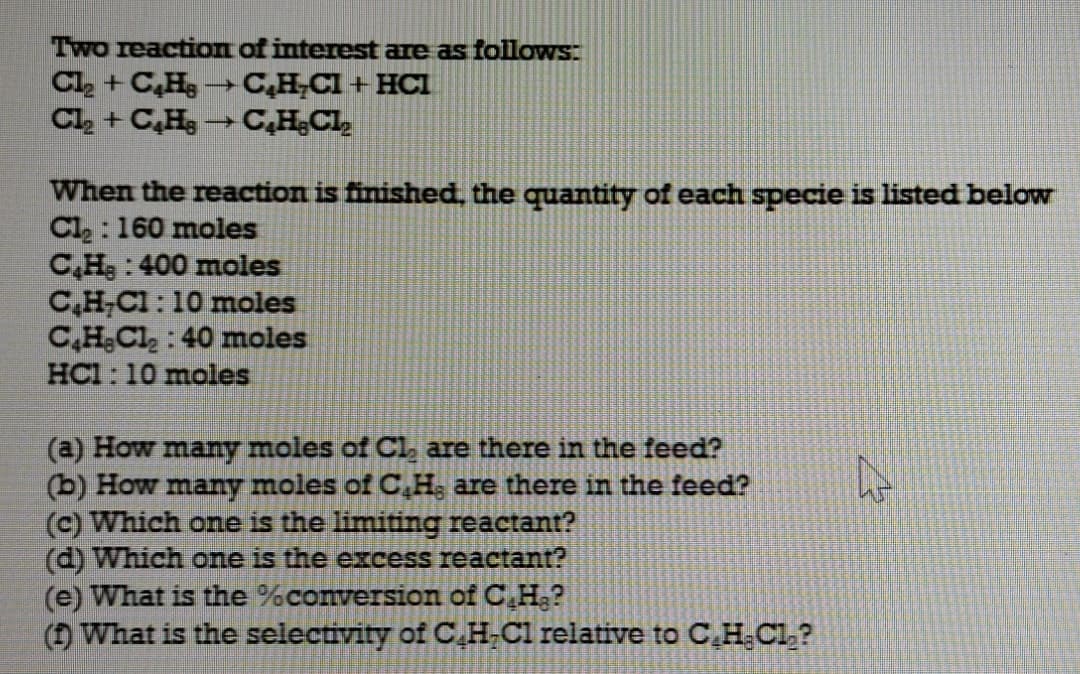Two reaction of interest are as followS: Cl2 + C,H Cl2 + C,Hs C,H-CI + HCI C,HCl, When the reaction is finished, the quantity of each specie is listed below Cl2 : 160 moles C,H : 400 moles C,H;Cl : 10 moles C,HCl : 40 moles HCl : 10 moles (a) How many moles of Cl, are there in the feed? (b) How many moles of C,H are there in the feed? (c) Which one is the limiting reactant?
Two reaction of interest are as followS: Cl2 + C,H Cl2 + C,Hs C,H-CI + HCI C,HCl, When the reaction is finished, the quantity of each specie is listed below Cl2 : 160 moles C,H : 400 moles C,H;Cl : 10 moles C,HCl : 40 moles HCl : 10 moles (a) How many moles of Cl, are there in the feed? (b) How many moles of C,H are there in the feed? (c) Which one is the limiting reactant?
Principles of Modern Chemistry
8th Edition
ISBN:9781305079113
Author:David W. Oxtoby, H. Pat Gillis, Laurie J. Butler
Publisher:David W. Oxtoby, H. Pat Gillis, Laurie J. Butler
Chapter17: Electrochemistry
Section: Chapter Questions
Problem 80AP
Related questions
Question

Transcribed Image Text:Two reaction of interest are as followS:
Cl + C,H →C,H,CI + HCI
Cl, + C,H→C,HCI,
When the reaction is finished, the quantity of each specie is listed below
Cl : 160 moles
C,H; : 400 moles
C,H;Cl : 10 moles
C,H;Cl, : 40 moles
HCl: 10 moles
(a) How many moles of Cl, are there in the feed?
(b) How many moles of C,H, are there in the feed?
(c) Which one is the limiting reactant?
(d) Which one is the excess reactant?
(e) What is the %conversion of C,H.?
( What is the selectivity of C. H-Cl relative to C,H,Cl,?
Expert Solution
This question has been solved!
Explore an expertly crafted, step-by-step solution for a thorough understanding of key concepts.
Step by step
Solved in 4 steps

Knowledge Booster
Learn more about
Need a deep-dive on the concept behind this application? Look no further. Learn more about this topic, chemistry and related others by exploring similar questions and additional content below.Recommended textbooks for you

Principles of Modern Chemistry
Chemistry
ISBN:
9781305079113
Author:
David W. Oxtoby, H. Pat Gillis, Laurie J. Butler
Publisher:
Cengage Learning

EBK A SMALL SCALE APPROACH TO ORGANIC L
Chemistry
ISBN:
9781305446021
Author:
Lampman
Publisher:
CENGAGE LEARNING - CONSIGNMENT

Principles of Modern Chemistry
Chemistry
ISBN:
9781305079113
Author:
David W. Oxtoby, H. Pat Gillis, Laurie J. Butler
Publisher:
Cengage Learning

EBK A SMALL SCALE APPROACH TO ORGANIC L
Chemistry
ISBN:
9781305446021
Author:
Lampman
Publisher:
CENGAGE LEARNING - CONSIGNMENT